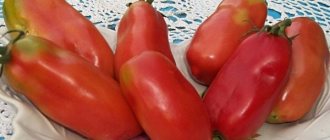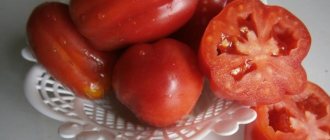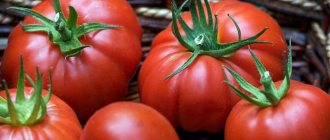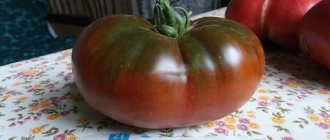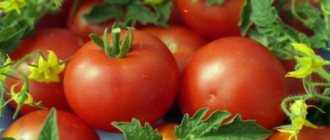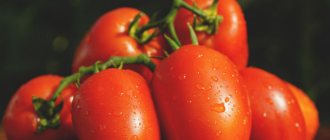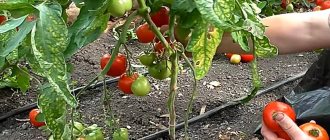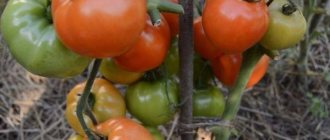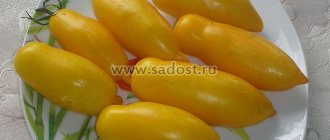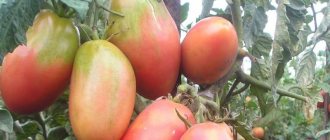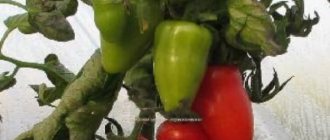Tomato Sovetsky is an excellent variety of raspberry tomatoes with large fruits and a rich, rich taste. He managed to win the love of many gardeners. Caring for it will require some effort, but is not at all difficult.
| Height | Landing location | Ripening time | Fruit color | Fruit size | Origin | Fruit shape |
| Tall | Greenhouse, Open ground | Mid-season | Pink | Large | Variety | Flat-round |
Description and characteristics of the variety
Soviet was selected for cultivation in the cool climate of Siberia. The bush is semi-determinant, as it stops growth on its own. But the height of the plant is 1.2-1.7 m, which is closer to the medium-sized type. Both in open and closed ground, you will definitely have to tie the tomatoes to supports or control the height manually. Shoots are prone to abundant formation of stepsons, which leads to thickening of the foliage.
The Soviet tomato variety is mid-season, the full growing season lasts 118-120 days after sowing the seeds.
Tomato is characterized by fruiting extended over time. Due to this property, the species is more often used for preparing salads and snacks than for preservation.
The fruits ripen from June to August. During the season, up to 3 kg of crop is harvested from each plant.
When ripe, tomatoes have pink skin and pulp and gain weight from 300 g to 500 g each.
The characteristics and description of the variety classify the fruits of the Soviet tomato as beef-type. Such vegetables are distinguished by their large size, fleshy, dense pulp and a small amount of free liquid in narrow seed chambers. The flat-round shape of the tomatoes with moderate ribbing is clearly visible in the photo.
A characteristic dark spot with a dense structure is formed in the area of the stalk. The taste is determined by the content of 3.5% sugars, and the presence of vitamin C is responsible for the presence of sourness.
Old popular Russian varieties of tomatoes
In the post-war years, Russian breeders were faced with the task of developing crop varieties that were capable of producing good yields with resistance to various diseases, because
it was necessary to “feed” the people. The following varieties differ in these characteristics. Early ripening varieties:
- Peremoga 165 – early ripening, variety 1951, grows well in open ground, is unpretentious and resistant to temperature changes, very good yield, bears fruit well in the shady part of the plot, short (40-50 cm), has resistance to fungal diseases, transportable . Fruits weighing up to 140 g, juicy, sweet, flat-round in shape, with slightly pronounced ribs and strong, smooth skin.
- White filling 241 - obtained in 1966 by Kazakh breeders, loved not only in Russia but also in other countries, early ripening, determinate with a good root system and high yield, unpretentious and able to tolerate cool summers and dry weather. Round, slightly flattened fruits up to 8 cm in size with a thin peel and weighing from 100 g, excellent taste, well transportable, with excellent properties for canning.
- The novelty of Transnistria is a variety with mid-early ripening, cultivated since 1967 in regions with a warm climate, feels good in open ground, in colder zones it is grown in greenhouses. The bush is low-growing and high-yielding, on which cylindrical smooth tomatoes grow, weighing 36-56 g, have a good taste, and are suitable for pickling with whole berries.
- Moskvich has been in the State Register since 1976, obtained by crossing the Nevsky and Smena varieties at the Institute of General Genetics named after. N.I. Vavilov, adapted for cultivation throughout almost the entire territory of Russia, even in the extreme conditions of the northern region. The variety ripens early and produces a good harvest of tasty fruits that ripen on the vine on the 90th day in the garden in warm summer. The bushes are strong, standard, low-growing (no more than 40 cm), the stepsons do not need to be torn off, and when taking stepsons, the tomatoes will appear earlier. The fruits weigh 60-80 g, sometimes up to 100 g, round, bright red with a sweetish taste, excellent for storing for future use and making ketchups and pastes. The variety is well preserved, the collected brown fruits ripen well and retain their taste during transportation.
- Ground Gribovsky 1180 - bred in 1950, tolerates low temperatures well, grows no more than 60 cm in height, ripens early, produces an early healthy harvest of small fruits weighing 60-100 g, is resistant to cold snaps, unpretentious, has a pleasant taste, but for the preparations are not entirely suitable, disease resistance is average.
Useful information! It is recommended to remove stepsons from determinate (low-growing) bushes to avoid overloading the bush with fruits.
The amount of watering is reduced as soon as the berries appear to avoid cracking. When watering, it is necessary to loosen the soil so that a crust does not form and the root system develops well.
Late ripening varieties:
- Volgogradsky 5/95 is a standard hybrid, bred in 1953 for greenhouses with a small space, an indeterminate heat-loving variety of late ripening with red, slightly ribbed and flattened round fruits weighing 80-120 g with a typical sweet and sour tomato taste, which are stored for a long time and are well tolerated transportation, has good resistance to fungal microbes. In the middle zone it is better to grow it in a greenhouse.
- New to Kuban - obtained by Krasnodar breeders in 1981 for open areas, not standard, medium-late, with low bushes, round medium-sized fruits with a smooth surface, has an excellent taste, has relatively good resistance to late blight and macrosporiosis. The berries are good both fresh and processed.
Purple leaves of such varieties indicate a lack of phosphorus and heat. Seedlings that have pale leaves and are very elongated should be thoroughly fed and gradually hardened off and watered a little less. A homemade remedy for growth can be prepared from a solution of baking soda or honey.
Important!
Planting and care
Soviet is a full-fledged variety, so you can not only buy seeds, but also prepare them yourself. They begin to sow tomatoes for seedlings in March in order to obtain bushes with a fully formed, viable root system by the second half of April. In comfortable conditions, plants achieve the required development in 2.5-3 months.
When planting in a permanent place, you should adhere to the checkerboard pattern. The optimal planting density is 3 plants per square meter.
The variety is equally suitable for greenhouses and open ground. In both cases, it is recommended to form tomato bushes with 1 or 2 main stems. Shoots require regular pinching, as well as garters to trellises or support.
Flowering of the Soviet tomato begins after the appearance of 9 true leaves. Future fruit clusters are formed every 3-4 shoots. To avoid weighting or small fruit on 1 plant there should not be more than 7 inflorescences, evenly spaced along the height of the bush.
For active growth and fruiting, Soviet tomatoes require constant feeding with phosphorus and potassium compounds.
The plant does not tolerate drought well; watering the bushes should be regular, but not excessive. Beds mulched with sawdust, hay or straw effectively retain moisture.
Reviews from gardeners
- Alexander, 33 years old:
Grown in a greenhouse. I have been growing tomatoes in a greenhouse for several years now. The Tomato Sovetsky variety is the most favorite tomato of my customers; it is always the first to leave the counter. It's all about the large, bright pink fruits; the fleshy sugar pulp is visible on the crack. The tomato is tasty, not sour, good in fresh salads. I didn’t encounter any particular difficulties in growing it. The only problem is cracking of the largest fruits, which occurs when I don’t get the watering right and add too much moisture. Therefore, I recommend to everyone not to let the soil dry out and always maintain moderate watering. - Maria S., 28 years old:
First time growing it in open ground. Despite the fact that the summer was dry, the plants bore fruit well. Drip irrigation saved the day. The fruits turned out to be large, tasty and sweet, about 6 kg per bush. I am very pleased with the harvest.
tomato Slot F1 - description and characteristics of the variety
Disease resistance
The producer of Soviet tomato seeds does not indicate immunity to crop diseases, but reviews attribute the variety to good resistance to fungal and viral infections.
When watering, it is important to avoid getting moisture on the leaves to reduce the risk of late blight. Stagnation of water at the roots of plants is also unacceptable; waterlogged stems and root systems are susceptible to fungal rot.
The use of specialized black agrofibre helps protect plants from infection and also serves as a replacement for mulching tomato beds.
To prevent diseases it is necessary:
- do not plant tomatoes in one place;
- observe crop rotation;
- spray bushes against insects;
- disinfect seed material.
Advantages and disadvantages
The Soviet tomato is characterized on the positive side by the following qualities:
- The seedlings are suitable for planting in greenhouses and open ground.
- Plants are resistant to low temperatures, as well as changes during the change of day and night.
- Thanks to the large, fleshy fruits, tomato yields remain high.
- The tomatoes are similar in size and do not crack or deform during the process of gaining mass.
- The good rich taste of the fruit is combined with a high content of nutrients.
The Sovetsky variety has no significant disadvantages, but some features can be noted:
- Tomatoes are not suitable for whole-fruit canning.
- Fruiting is spread out over time, which makes harvesting for the winter difficult.
- The bushes must be shaped, pinched, tied, and the number of fruit clusters must be normalized.
How should you care?
Tall tomato bushes of the indeterminate variety are rewarded with a generous harvest of beautiful and large tomatoes if they are formed correctly and on time. Every week you need to remove the stepsons that form from the axils of the leaves. Side shoots should not be allowed to reach 7 cm. In greenhouses in the middle zone and in the open ground of the southern regions, no more than 7 inflorescences are left. The top of the plant is cut off; there should be only a couple of leaves above the last brush.
The bush is formed until the fruits set. Preference is given to one stem, then the sun illuminates the tomatoes from all sides, and they ripen and gain sweetness.
Tomatoes are fed with mineral fertilizers that contain phosphorus and potassium. This is done once every week and a half until several inflorescences appear.
The beds are mulched with grass, hay or sawdust. Humidity is maintained at the same level. Drops of water should not fall on the leaves, otherwise the tomatoes will crack and lose their sweetness.
Sovetsky variety tomatoes are used in salads and produce delicious juice. In the greenhouse, excellent harvests ripen even in cold and damp summers.
Similar varieties
Soviet analogues include:
- Grandmother's Secret tomatoes also have a flat-round shape, pink peel and pulp. The first fruits ripen about 1 week earlier, gaining weight up to 700 g. Unlike the Soviet bushes, they are of the indeterminate type and do not stop growing during the growing season. The variety is not resistant to crop diseases.
- Semi-determinate tomato Rose Honey stops growth at 0.6-1.4 m, depending on the type of soil. The yield is 6 kg per plant. Heart-shaped pink fruits gain weight of 0.6-0.8 kg and begin to sing 115 days after sowing. The bushes are resistant to infections.
- The mid-season tomato Inna is classified as indeterminate with a height of up to 2 m. The growing season takes at least 112 days. Tomatoes have a wide range in size, weighing from 260 g to 680 g. The red fruits have a flat-round shape and dense, sugary pulp.
